Oceanic current is the large-scale movements of seawater that flow through the world’s oceans in well-defined patterns. These currents play a vital role in regulating the Earth’s climate, distributing heat, transporting nutrients, and supporting marine life. Ocean currents are generated by various forces acting upon the water, such as wind, temperature differences, salinity variations, and the Earth’s rotation.

Table of Contents
Causes of Oceanic Currents
Oceanic currents are the steady, directional movements of ocean water, flowing across the globe’s vast seas and oceans. These currents are not random; they are driven by a combination of interconnected natural forces that operate on both surface and deep levels.
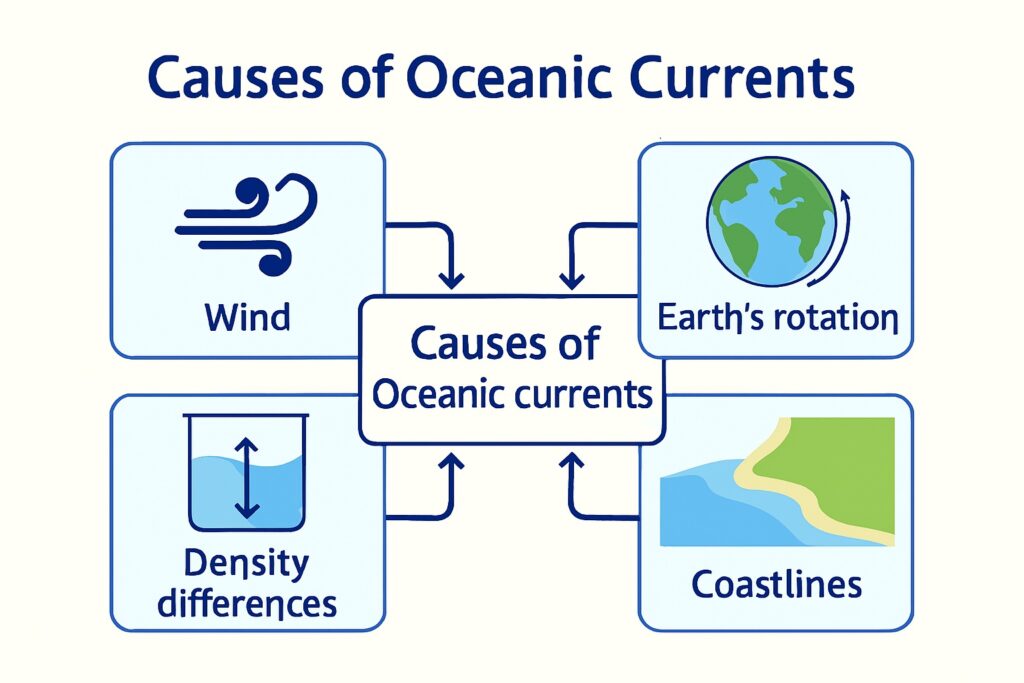
1. Wind
Wind is the most significant force driving surface ocean currents. When wind blows across the surface of the ocean, it transfers energy to the water through friction. This creates surface currents that move in the direction of the prevailing wind. The trade winds near the equator and westerlies in the mid-latitudes are especially important in shaping large ocean currents.
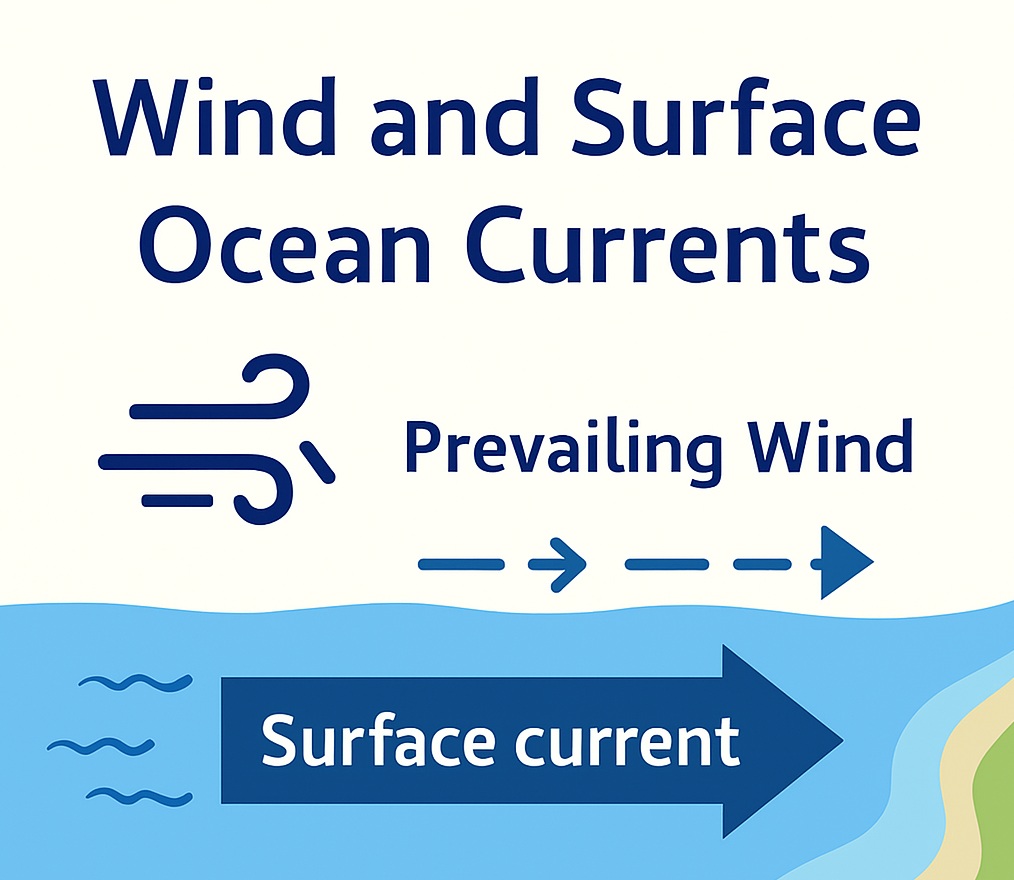
2. Coriolis Effect
The Earth’s rotation causes a phenomenon known as the Coriolis effect, which deflects moving water. In the Northern Hemisphere, currents are deflected to the right, while in the Southern Hemisphere, they are deflected to the left. This effect, combined with wind, helps form the circular patterns of surface currents in major ocean basins. Without the Coriolis effect, currents would follow straight paths instead of curved ones.

3. Differences in Temperature and Salinity
The thermohaline circulation refers to deep ocean currents driven by differences in temperature and salinity. Cold, salty water is denser and tends to sink, while warmer, less salty water rises. This vertical movement of water forms a global conveyor belt of deep-sea currents that circulate slowly but steadily throughout the world’s oceans. This process plays a major role in redistributing heat and regulating Earth’s climate.
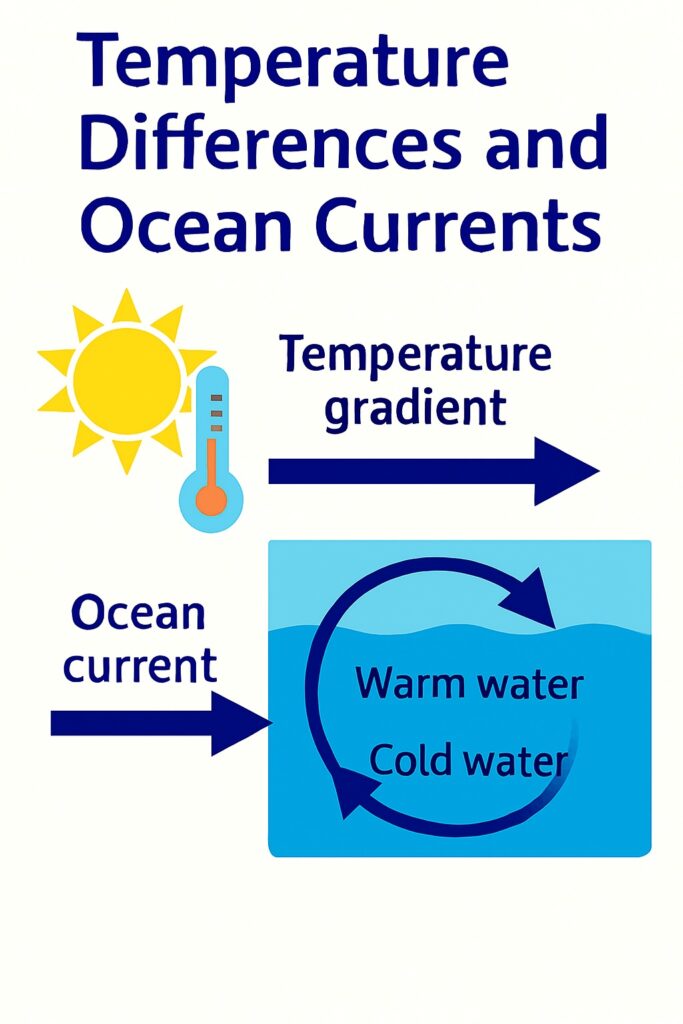
4. Gravitational Pull of the Moon and Sun
The gravitational forces of the Moon and Sun create tides, which lead to tidal currents. These currents are most noticeable along coastlines, estuaries, and shallow seas. Unlike surface currents that are mostly driven by wind, tidal currents change direction and strength regularly based on the lunar cycle. Though local in effect, tidal currents are important in coastal water movement and ecosystem balance.
5. Shape of the Ocean Basins and Coastlines
The physical shape of the ocean floor and surrounding landmasses greatly influences the direction and behavior of currents. Continental margins, underwater ridges, islands, and seafloor features can deflect, block, or guide ocean currents. Narrow channels may speed up currents, while wide basins allow them to spread out. These natural boundaries help define the unique current systems in each ocean.
6. Solar Heating and Unequal Distribution of Heat
The Sun heats different parts of the ocean unequally. Equatorial waters receive more direct sunlight and become warmer, while polar regions receive less sunlight and stay colder. This temperature difference causes water to move: warm water tends to flow toward the poles, and cold water moves toward the equator. This heat-driven movement contributes to both surface and deep water currents.

7. Gravity and Pressure Differences
Gravity helps maintain the ocean’s slope and causes water to move from regions of higher pressure to lower pressure. Although not as obvious as wind or temperature, gravity-induced movement contributes to the overall flow of ocean currents, especially when combined with other forces like wind and Earth’s rotation.
Oceanic currents are caused by a variety of factors, including winds, tides, and differences in water density. Wind-driven currents occur when wind blows across the surface of the ocean, causing water to move in response. Tidal currents are created by the gravitational pull of the moon and sun, which causes the ocean to rise and fall, creating a flow of water.
Density-driven currents are caused by differences in the density of water due to changes in temperature and salinity. For example, water near the poles is colder and denser than water near the equator, causing it to sink and creating a flow of water known as a thermohaline circulation.
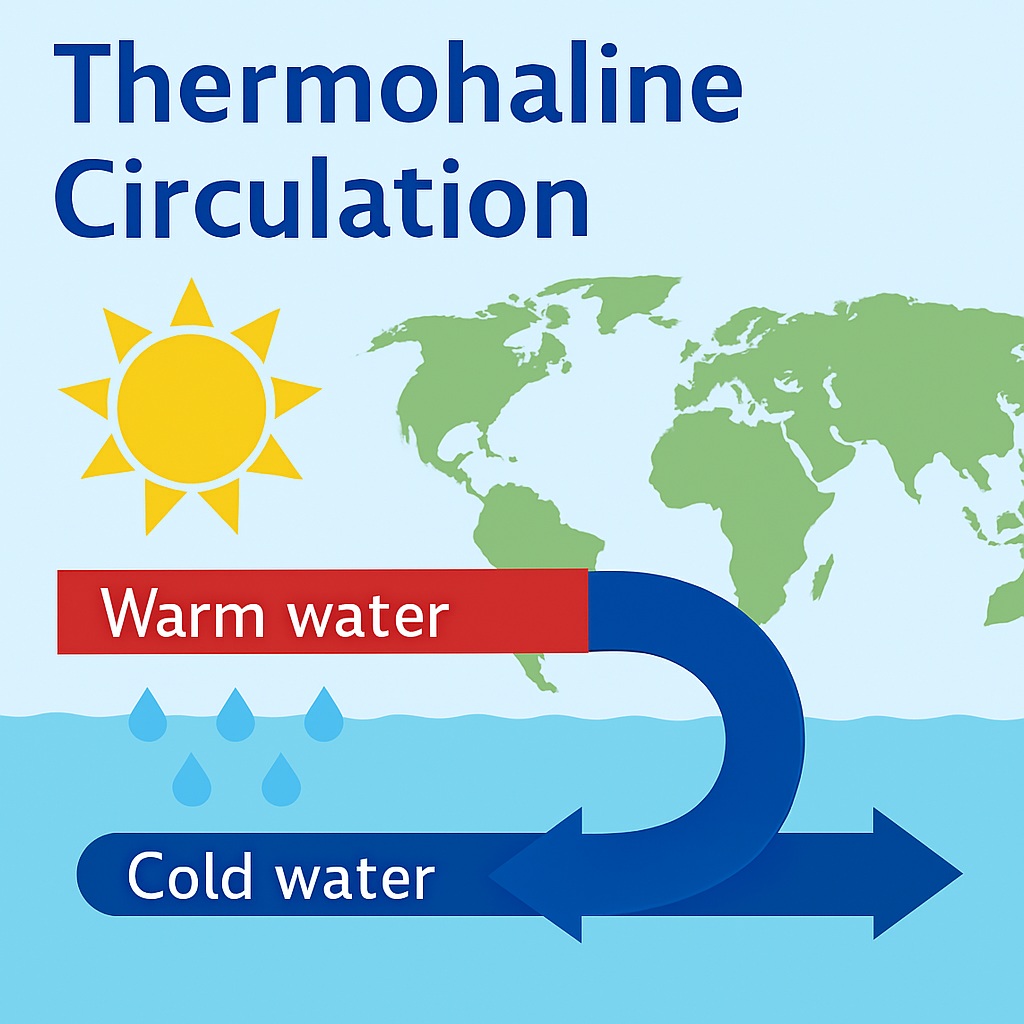
Effects of Oceanic Currents
Oceanic currents have far-reaching effects on the Earth’s climate, coastline, and ecosystems. They play a crucial role in shaping the planet’s climate by transporting heat from the equator to the poles, helping to regulate the Earth’s temperature. Additionally, oceanic currents can influence the distribution of marine life, as they carry nutrients and other important elements to different parts of the ocean, supporting the growth and abundance of marine species.
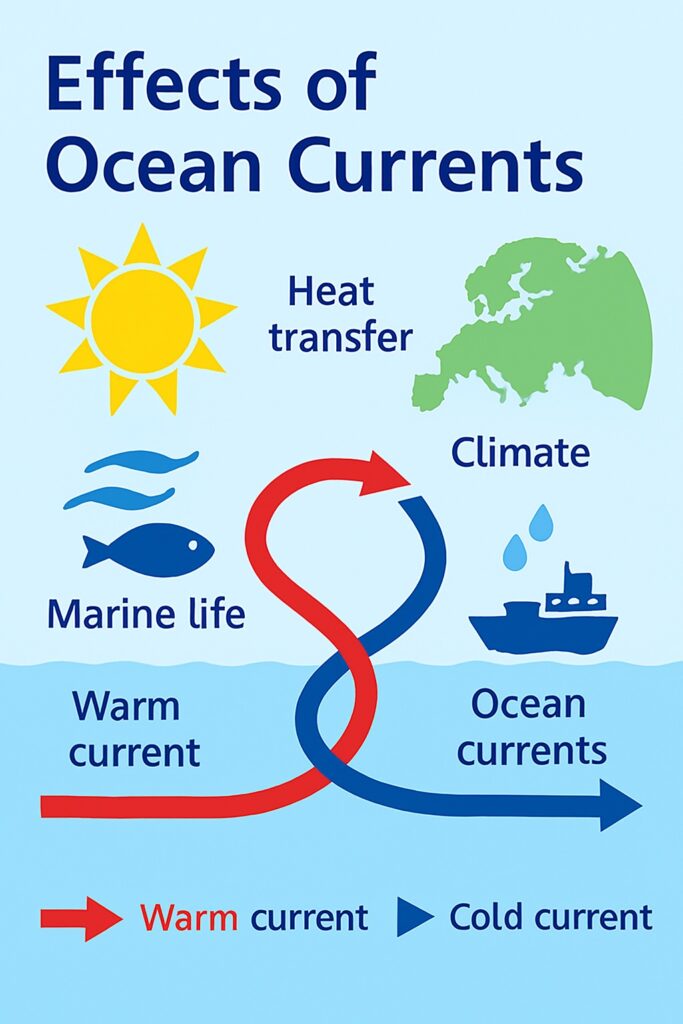
Oceanic currents can also have a significant impact on human activity, particularly in the areas of shipping, fishing, and coastal development. For example, oceanic currents can create favorable conditions for fishing, helping to sustain fishing communities and support the fishing industry. However, oceanic currents can also pose a threat to shipping, as they can cause ships to drift off course or be swept away by strong currents.
Finally, oceanic currents can also have a significant impact on coastal communities, as they can cause erosion and change the shape of coastlines. In extreme cases, oceanic currents can cause tsunamis, which can have a catastrophic impact on coastal populations.
Importance of Ocean Current
Oceanic currents are an essential part of the Earth’s natural systems, and their importance cannot be overstated. They play a crucial role in regulating the planet’s climate, supporting marine life, and shaping its coastlines. Furthermore, oceanic currents are a vital source of information for scientists, as they help to track the movements of ocean water and monitor changes in the ocean’s temperature and salinity.
In conclusion, oceanic currents are a vital and powerful aspect of the Earth’s natural systems, playing a crucial role in regulating the planet’s climate, supporting marine life, and shaping its coastlines. Whether it is through monitoring and predicting their behavior, studying their impact on the ocean’s ecosystems, or utilizing them as a source of renewable energy, we must continue to understand and appreciate the importance of
What are the types of Oceanic Currents?
Oceanic currents can be classified into two main types based on their direction of flow and temperature: Warm and Cold ocean currents.
Warm Oceanic Currents
Warm oceanic currents are currents that flow from the equator towards the poles, transporting warm water from the tropical regions towards the colder regions. These currents are generally slower and broader than cold oceanic currents and play a crucial role in regulating the Earth’s climate by distributing heat around the planet. Some examples of warm oceanic currents include the Gulf Stream, the North Atlantic Drift, the Agulhas Current, and the Kuroshio Current.
Cold Oceanic Currents
Cold oceanic currents are currents that flow from the poles towards the equator, transporting cold water from the polar regions towards the warmer regions. These currents are generally faster and narrower than warm oceanic currents and play a crucial role in regulating the Earth’s climate by absorbing and distributing heat around the planet. Some examples of cold oceanic currents include the California Current, the Humboldt Current, and the Antarctic Circumpolar Current.

In addition to these two main types of oceanic currents, there are also intermediate currents, which are currents that flow from one region to another, carrying water that is neither particularly warm nor particularly cold. Intermediate currents play a crucial role in connecting the warm and cold currents, helping to distribute heat, moisture, and nutrients around the planet.
It’s important to note that oceanic currents are influenced by a variety of factors, including wind patterns, water density, and the Earth’s rotation. As such, the behavior and impact of oceanic currents can be complex and difficult to predict, making the study of oceanic currents a critical field of research for scientists and policymakers alike.
Ocean Current Vs. Ocean Wave
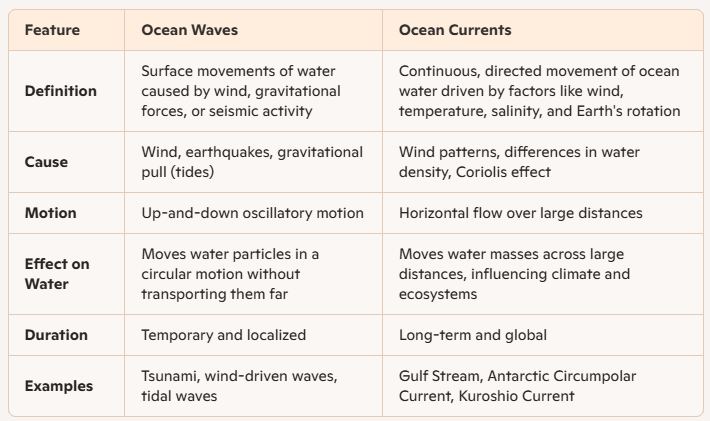
Important Currents
- Gulf Stream: The Gulf Stream is a warm ocean current that flows from the Gulf of Mexico towards the North Atlantic. This current is one of the most well-known oceanic currents and is known for its significant impact on the climate of western Europe. The warm water carried by the Gulf Stream helps to keep western Europe relatively mild, even during the winter months.
- North Atlantic Drift: The North Atlantic Drift is a continuation of the Gulf Stream, flowing towards the northwest coast of Europe. This current is responsible for the mild climate of western and northern Europe, as well as the temperate waters of the North Atlantic.
- California Current: The California Current is a cold ocean current that flows south along the west coast of North America, from Alaska to Baja California. This current helps to regulate the temperature of the coastal regions and is important for the fishing industry, as it carries cold, nutrient-rich waters that support a diverse array of marine life.
- Humboldt Current: The Humboldt Current is a cold ocean current that flows along the west coast of South America, from Peru to Chile. This current is responsible for the arid climate of the Atacama Desert and is important for the fishing industry, as it supports one of the world’s largest fish stocks.
- Agulhas Current: The Agulhas Current is a warm ocean current that flows along the southeast coast of Africa, from Mozambique to South Africa. This current is important for the climate of southern Africa, as it helps to bring moisture to the region, supporting the growth of vegetation and agriculture.
- Antarctic Circumpolar Current: The Antarctic Circumpolar Current is the largest ocean current in the world, flowing from west to east around the Antarctic continent. This current helps to distribute heat and nutrients around the Southern Ocean, and is important for regulating the Earth’s climate and supporting the diverse array of marine life in the region.
- Kuroshio Current: The Kuroshio Current is a warm ocean current that flows along the east coast of Japan, from Taiwan to the Japanese archipelago. This current is responsible for the mild climate of Japan, and is also important for the fishing industry, as it carries warm, nutrient-rich waters that support a diverse array of marine life.
- Equatorial Currents: Equatorial currents are a series of currents that flow from east to west along the equator, connecting the Atlantic, Indian, and Pacific Oceans. These currents play a crucial role in regulating the Earth’s climate and are important for the distribution of heat, moisture, and nutrients around the planet.
| Oceanic Current | Continent | Type |
|---|---|---|
| Gulf Stream | Europe | Warm |
| North Atlantic Drift | Europe | Warm |
| California Current | North America | Cold |
| Humboldt Current | South America | Cold |
| Agulhas Current | Africa | Warm |
| Antarctic Circumpolar Current | Antarctica | Cold |
| Kuroshio Current | Asia | Warm |